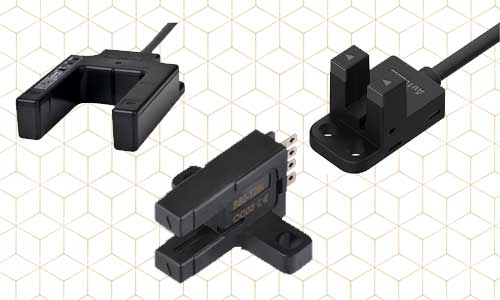Fork Sensor [How it Works, Features and Applications]
A fork sensor or slot sensor is a kind of registration sensor that detects objects passing through the slot based on through-beam photoelectric technology that is a proper device for the detection of small parts up to 06 mm. these sensors are U and L-shaped and consist of an emitter to emit light and a receiver to receive light that detects the presence or absence of an object through its receiver.
In fork sensors the emitter and receiver are in alignment located in a fixed and rugged one-piece stainless steel housing and detection of parts happen within the fork range.
Because of this feature, they can be adjusted quickly and are suitable for use in hygiene areas. These sensors With the highest accuracy and speed in performance, are responsible for detecting the presence of different types of labels in industrial automation.
It has a potentiometer to adjust the sensitivity that causes small differences within the limited light to be recognized. These non-contact sensors can identify anything, in any case of color, texture, or reflectivity. The fork sensor can detect even the smallest optical aberrations.
optical (IR and laser) and ultrasonic are two types of fork sensors. optical fork sensors operate based on the use of infrared (non-visible) light sources and their sensitivity can be adjusted manually by means of a potentiometer or teach-in through a button on the sensor face.
Browse our wide selection of Tachometer products category with the highest quality.

Class I visible laser light sources have very small diameter spot sizes (<0.5 mm) that are used in situations for the detection of small parts or where there is a need to detect the precise position of objects.
The output of this sensor is the open collector NPN, which places the load between the positive wire and the power supply. Also, the output has Light On and Dark On modes, which are selected by reversing the supply voltage.
This kind of sensor has a Fast reaction speed and due to its special shape is suitable for distance measurement and measuring the speed of linear motions and rotational speed.
Features and Advantages of Fork Sensor
- Different sizes
- Easy and direct installation capability
- Excellent ambient light immunity
- Same mechanical and optical arms
- High reliability and repeatability and optical resolution
- Capability of transparent and liquid detection
- Adjustable sensitivity
- Resistant in temperature fluctuations and mechanical stress
- Resistant to ambient light and electrical noise
- Protection against positive and negative pole switching
- Overcurrent protection and short circuit
Fork Sensors Applications
- In-track level monitoring
- Presence of parts in the nest in feeding technology
- Web edge monitoring in the packaging
- Counting tasks in feeding, assembly, and handling applications
- Label detection and positioning clear bottles
- Color verification to detect invisible marks on products
- Belt edge and guide control.
- Packaging applications
- Print and paper industries
- Transparency and water detection
We recommend the following articles for your consideration:
Laser Sensor [Working Principle, Types, Features, Applications]
Recent Posts
-
Booster Pump Troubleshooting and Maintenance: How to Fix and Prevent Common Issues
1. Introduction Imagine turning on your faucet only to be greeted with a weak trickle of water when …22nd Apr 2025 -
Energy-Efficient Booster Pumps: Selection and Tips for Maximizing Performance
1. Introduction Imagine never having to deal with fluctuating water pressure, noisy pumps, or skyroc …19th Apr 2025 -
Booster Pumps for Sustainable Water Systems: Irrigation and Rainwater Harvesting Solutions
1. Introduction Water scarcity is no longer a distant threat—it’s a reality affecting millions …16th Apr 2025

![Fork Sensor [How it Works, Features and Applications] Fork Sensor [How it Works, Features and Applications]](https://cdn11.bigcommerce.com/s-sgprcd6/images/stencil/1193x795/uploaded_images/fork-sensor.jpg?t=1655972645)


